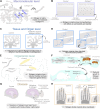Nidogen in development and disease
- PMID: 38550383
- PMCID: PMC10972974
- DOI: 10.3389/fcell.2024.1380542
Nidogen in development and disease
Abstract
Nidogen, also known as entactin, is a multifunctional glycoprotein that plays a crucial role in the maintenance of the basement membrane (BM), morphogenesis and neuronal plasticity. This review aims to provide an overview of the structural features, molecular interactions and diverse functions associated with Nidogen. As a bridging molecule within the BM, Nidogen acts as a linchpin connecting various extracellular matrix (ECM) components. Its involvement in tissue development, homeostasis, and pathological conditions underscores its biological and medical significance. We discuss the current state of knowledge regarding Nidogen's role in tissue maintenance, cell adhesion, migration, and signaling, shedding light on its intricate contributions to physiological and pathological processes.
Keywords: basement membrane; collagen; dandy-walker malformation; entactin; extracellular matrix; laminin.
Copyright © 2024 Töpfer and Holz.
Conflict of interest statement
The authors declare that the research was conducted in the absence of any commercial or financial relationships that could be construed as a potential conflict of interest.
Figures


References
-
- Ackley B. D., Kang S. H., Crew J. R., Suh C., Jin Y., Kramer J. M. (2003). The basement membrane components nidogen and type XVIII collagen regulate organization of neuromuscular junctions in Caenorhabditis elegans . J. Neurosci. 23, 3577–3587. 10.1523/JNEUROSCI.23-09-03577.2003 - DOI - PMC - PubMed
Publication types
LinkOut - more resources
Full Text Sources
Research Materials

